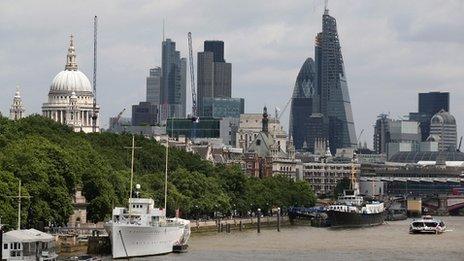Londoners 'take the most university places'
- Published

Youngsters in the capital are much more likely to go to university
Young people in London are 43% more likely to go to university than their counterparts in the north-east of England, says a report from the Higher Education Funding Council for England.
The funding council has published an analysis of changing patterns of young people going to university.
It shows a widening regional gap, with Londoners taking an increasingly disproportionate number of places.
The gender gap has widened too, with women more likely to go to university.
The study from the funding council examines trends in young people entering higher education in England, between 1998-99 and 2011-12.
Rising numbers
The overall underlying trend is that more young people are going to university, with the proportion of 18-year-olds getting places rising from 30% to 38%.
But this is not an even spread.
The increase has been much greater among young women, with a current gender gap of 12%, compared with 3% in the late 1990s.
This gender gap was even more extreme in the poorest areas, with women 35% more likely to go to university.
The gap in university entry between rich and poor remains as wide in this decade as it was in the 1990s, although both groups have increased their numbers.
"Young people in the most disadvantaged areas would need to treble their participation rate in order to match the rate of those from the most advantaged areas," says the study, observing that the difference remained "broadly stable".
But there had been significant regional shifts.
London had the highest levels of participation in 1988-99 and this was even more pronounced by 2011-12. The proportion going to university has risen from 35% to 48%.
Schools in the capital have become among the highest performing in the country and a much higher proportion of youngsters go on to university than anywhere else.
Last to first
What makes this particularly striking is that in 1998-99, youngsters in London in poorer "low participation" areas were the least likely in the country to go to university. But by 2011-12 they had gone from the bottom to the top of the regional league table.
There are 23% of youngsters in London living in poorer areas now entering university. The lowest level of entry among the most deprived is now in the south-east, previously amongst the highest.
The study says that more than half of all the extra disadvantaged entrants brought into higher education across England were from London.
The highest level of participation by constituency, Wimbledon, has four times the level of university entry for the lowest, Nottingham North.
This more local breakdown showed the highest levels of university entry in south-west and north-west London, with the highest rates of increase clustered around north-east and south-east London.
The report highlights the places with the lowest levels of university entry, coastal towns, former industrial towns in the midlands and north, rural areas of the south-west, the east midlands and east of England.
Along with Nottingham North, the other lowest individual constituency was Bristol South.
Biggest rise
In terms of the increase in the young people going to university, the biggest increases in the country were in Barking, Lewisham Deptford, Croydon North, Bermondsey and Greenwich.
In contrast, North West Norfolk, Bognor Regis and Copeland in Cumbria saw numbers going into reverse.
The lowest regional level of increase over these years was the south-west.
Prof Les Ebdon, head of the Office for Fair Access, welcomed the "sustained progress" in increasing participation in higher education.
But he said that narrowing the gap between the most and least advantaged would mean early intervention.
"This means encouraging children from an early age to think about higher education as an option, supporting teenagers as they make key decisions, and working with employers to reach out to potential mature students."
He also warned that the fall in part-time student numbers would have a disproportionate impact on poorer families.
Rachel Wenstone, vice-president of the National Union of Students, said: "It's fantastic to see that young people still recognise the value of higher education, but it remains a national embarrassment that where you're from remains such a key factor in whether or not you go on to university."
Prof Michael Gunn, chair of Million+, representing new universities, said: "The increase in the number of young people from disadvantaged backgrounds entering higher education is one of the great British success stories of the last 15 years.
"This is the result of governments being willing to fund an expansion in university places and widening participation initiatives and modern universities rising to the challenge. Without this commitment and increased investment in schools it is unlikely that any of this would have happened."
- Published22 October 2013
- Published16 August 2013
- Published16 October 2013